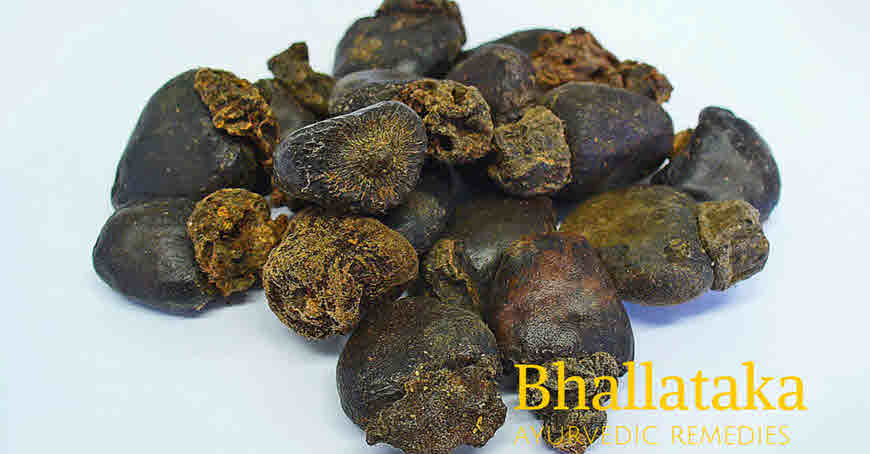Bhallaataka or Bhallata is an Ayurvedic name of medicinal tree Semecarpus anacardium. In India, it is found in Punjab, Assam, Khasi Hills, Madhya Pradesh and Peninsular India. It is a moderate-sized deciduous tree that grow in dry or moist deciduous forests. This tree is beneficial in treating rheumatoid arthritis, skin diseases, tumors and malignant growths. The other conditions in which it is useful is asthma, neuralgia, sciatica, gout, hemiplegia, and epilepsy.

The kernel oil is used externally on gout, leucoderma, psoriasis and leprosy. Detoxified nut are used for medicinal purpose. The fruits from which nuts are obtained are collected when they resembles ripened Jamun fruits (Syzygium cumini). The fruit pericarp is used as substitute for marking ink, hence this tree is also known as Marking Nut.
General Information
- LATIN NAME: Semecarpus anacardium SYNONYMS: Anacardium orientale
- FAMILY: Anacardiaceae
- Vernacular names
- ENGLISH: Marking nut, Oriental cashee
- COMMON INDIAN NAMES: Bibbaa, Bhallaataka, Bhela, Bhilawa
- ANDHRA PRADESH: Nalla jeedi
- SANSKRIT: Bhallataka, Aruskara, Agnika, Agnimukha, Anala, Vatari, Mahatiksna, Sphotabijaka,
- UNANI: Baladur, Bhilayan, Bhilaavan
- SIDDHA/TAMIL: Shenkottei, Erimugi
- ASSAMESE: Bhelaguti
- BENGALI: Bhela
- GUJRATI: Bhilam
- HINDI: Bhilawa
- KANNADA: Bhallataka
- MALAYALAM: Chera
- MARATHI: Bibba
- ORIYA: Bhollataki, Bholai
- PUNJABI: Bhilawa
- TAMIL: Tatamkottai, Scramkotati
- TELUGU: Nallajidi, Nallajidiginga
- URDU: Baladur, Bhilavan
Parts used: Seeds, gum and oil
CHEMICAL COMPOSITION OF NUTS
Anacardic acid, cardol, catechol, anacardol and fixed oit, sernicarpoi, bhilawanol
Ayurvedic Properties and Action on body
Rasa (Taste): Kashaya/Astringent, Madhura/Sweet
Guna (Characteristics): Laghu/Light, Snigdha/Unctuous, Tikshna/Sharp
Virya (Potency): Ushna/Hot
Vipaka (Post Digestive Effect): Madhura/Sweet
Ayurvedic medicines containing Semecarpus anacardium as igredient: Sanjivani vati, Bhallatakadi Modaka
Dosage:
Detoxified fruit—1-2 g in milk confection.
Ayurvedic medicinal uses
Bhallataka is used in Ayurveda for centuries. It reduces vata/wind, kapha/mucous but increases pitta. It has varied uses in Ayurveda and useful in skin diseases, fever, piles, loose motions, epilepsy, neuralgia and ulcers. Pericarp oil promotes the flow of bile into the intestine. Seeds oil is used externally on rheumatism.
Bhallataka seeds are toxic. So in Ayurveda, they are used only after proper detoxification. For this purpose, the fruits (after removing the attachment of the thalamus) are soaked in go-mutra/cow’s urine for seven days and thereafter in go-dugdha/cow’s milk for 7 days. The seeds are then put into a bag containing coarse brick powder with which they are rubbed carefully to reduce the oil content. Then the fruits are washed with water and dried in air.
Side-effects & warning
- Bhallataka is used in Ayurveda after proper purification. The nuts should not be used as home-remedy.
- The seeds are hot in potency that gives heating effect to the body. Therefore it should not be used in hot weather.
- It should not be used by kids and pregnant women.
- The nuts has anti-fertility effect.
- People with excess bile should not use it.
Good simple collection of Information. But it lack info about purity and quality.
It is most vulnerable to get adulterated.
Consider it.